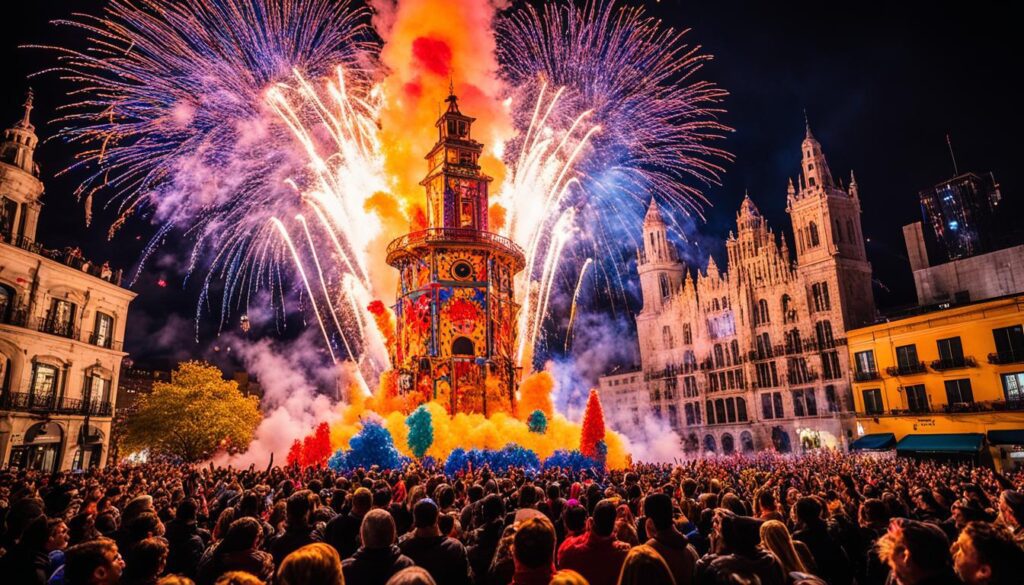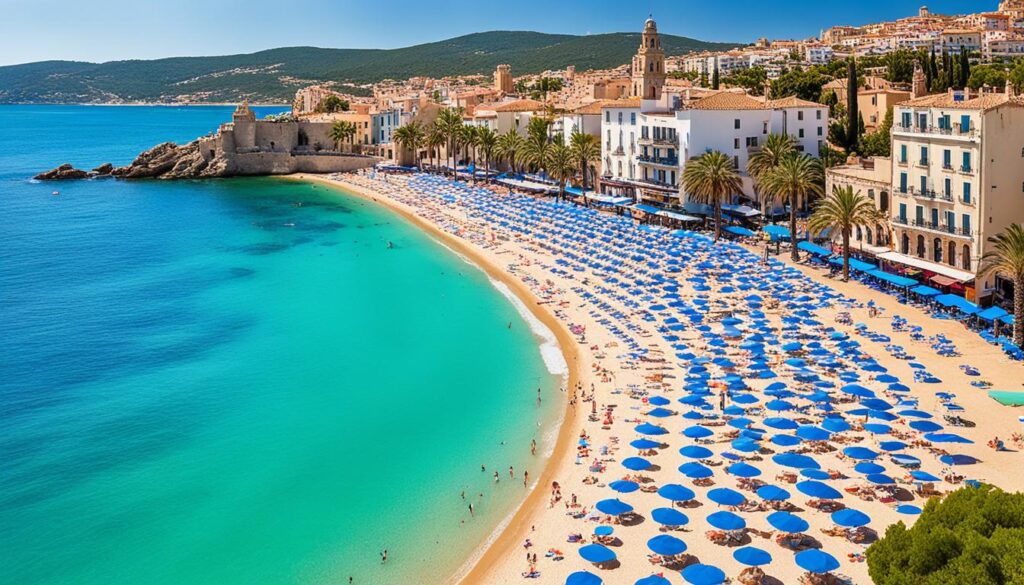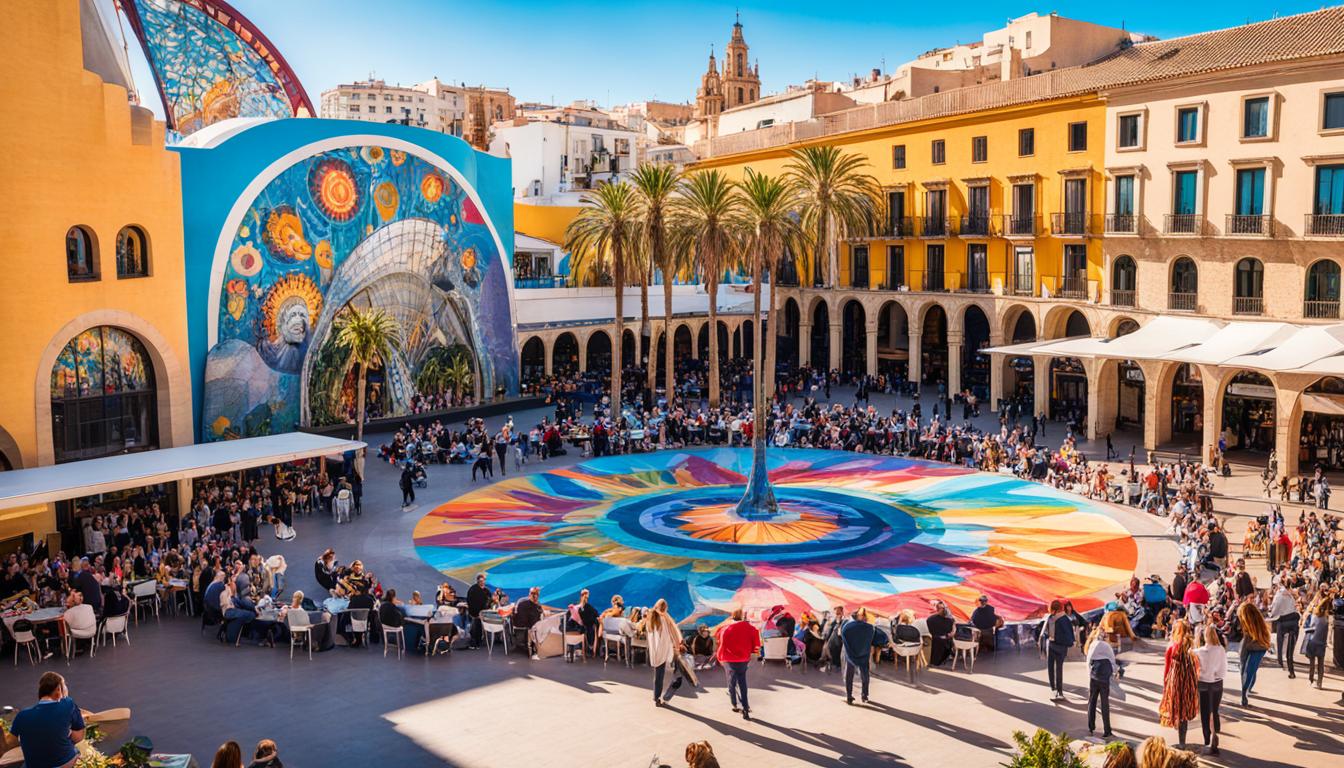Valencia sits on Spain’s eastern coast, full of history, culture, and energy. It’s Spain’s third-largest city, with a mix of ancient Roman, Moorish, and modern influences. The city has a great climate, beautiful buildings, and a food scene that’s hard to beat.
People love Valencia for its mix of old-world charm and modern vibes. Visitors feel the city’s warmth and passion, getting lost in its lively community.
Key Takeaways
- Valencia is a vibrant city with a rich cultural heritage, blending ancient and modern influences.
- The city is renowned for its Mediterranean lifestyle, stunning architecture, and thriving culinary scene.
- Valencia’s community spirit and welcoming atmosphere captivate visitors from around the world.
- The city’s strategic location on Spain’s eastern coast has played a significant role in its historical development.
- Valencia’s passion and community spirit are evident in its vibrant festivals and celebrations.
Introduction to Valencia’s Vibrant Culture
Valencia sits by the sparkling Mediterranean coast. It’s a city where Valencia’s deep history meets modern life. As Spain’s third-largest city, it’s a center of cultural exchange. This shows the area’s rich heritage.
Valencia’s Strategic Location and Historical Significance
Valencia is at the heart of the mediterranean region. It has been key in the history of many civilizations. Founded in 138 BC by the Romans, it later became part of the Moorish empire. Then, it was taken back by the Christian Kingdom of Aragon in the 13th century.
This history has left behind many historic landmarks and architectural wonders. These have shaped Valencia’s culture.
Blend of Influences: Roman, Moorish, and Contemporary
Walking through Valencia, you feel its cultural exchange everywhere. The Valencia Cathedral shows its Christian roots with its Gothic spires. The Silk Exchange, or Lonja de la Seda, tells of its rich past in the 15th century.
This mix of roman, moorish, and modern styles gives Valencia a special charm. It draws visitors from all over the world.
“From Conflict to Renaissance: Navigating the Complexities of the Modern Era” explores Valencia’s historical complexities and its transformation during the Renaissance.
The Art and Architecture of Valencia
Valencia’s culture shines through its beautiful art and architecture. The Valencia Cathedral stands out with its mix of styles. It’s said to hold the Holy Grail, the cup from the Last Supper.
The Silk Exchange (La Lonja de la Seda) is another gem. It’s a UNESCO World Heritage Site that shows off Valencia’s past wealth. This Gothic building has stunning designs and big halls.
Valencian Architecture: A Tapestry of Styles
Valencia’s buildings tell a story of history and culture. They mix styles from Moorish times to the Christian era. You’ll see Islamic, Gothic, and Renaissance touches.
The Modernismo movement also left its mark. This style is seen in many beautiful buildings. The Colon Market is a great example, designed by Francisco Mora Berenguer in 1916.
Today, Valencia keeps adding to its architecture. The City of Arts and Sciences and Veles e Vents building are modern highlights. They were made by architects Santiago Calatrava and David Chipperfield.
Valencia’s buildings take you on a journey through time. From old landmarks to new designs, the city’s art and architecture are truly captivating.
valencia spain culture
Valencia, a city on Spain’s eastern coast, is famous for its rich food traditions. These traditions come from different cultures that have influenced the area. At the center of it all is the paella, a dish that represents Valencia.
Paella: The Iconic Dish of Valencia
Paella comes from the fertile lands around Valencia. It’s a dish that unites people. Made with special rice, saffron, olive oil, and various meats and veggies, each paella tells a story of the chef’s skill and the area’s rich ingredients.
The tradition of making paella is big in Valencian culture. Families and friends come together to enjoy this meal.
Fideuà: The Noodle-Based Cousin of Paella
Valencia’s Valencian cuisine also has fideuà, a dish similar to paella but with noodles. It’s made with short noodles and topped with seafood, reflecting the Mediterranean Sea’s flavors.
These local food dishes are key to Valencia’s culinary traditions. Trying paella or fideuà lets visitors taste the area’s deep cultural roots.
“Paella and fideuà are more than just dishes – they are the embodiment of Valencia’s vibrant spirit, where the flavors of the sea and the land converge to create culinary masterpieces.” – Manuel Raga, Valencian food historian
Festivals and Celebrations in Valencia
Valencia, a city on Spain’s east coast, is famous for its vibrant festivals and cultural events. These events highlight the Valencian community’s heritage, traditions, and spirit. The Las Fallas festival is a key event, filled with fire, music, and community pride every March.
Las Fallas: The Vibrant Festival of Fire
The Las Fallas festival lasts a week and ends on March 19th, Saint Joseph’s Feast Day. It’s a celebration of creativity, featuring giant sculptures made of papier-mâché and wood. These “fallas” are satirical and represent current events and popular culture.
Local communities and guilds create these sculptures, competing for the top “falla” award. The festival’s climax is the Crema, or the burning of the fallas. This happens on the last night, with people watching as the sculptures go up in flames.

The festival also includes street parades, music, and traditional dances. The Ofrenda procession is a touching moment, where people offer flowers to the Virgin Mary. It shows the festival’s deep religious and cultural meaning.
The Las Fallas festival is a celebration of culture, attracting millions yearly. It’s a unique mix of fire, art, and community spirit.
Valencia’s City of Arts and Sciences
In the heart of Valencia, an architectural wonder awaits. The City of Arts and Sciences is a place of innovation and cutting-edge design. It’s a cultural and scientific complex that has become a top spot for visitors. Architects Santiago Calatrava and Félix Candela designed it, showing Valencia’s love for art, science, and culture.
The Hemisfèric is the main attraction, opening in 1998. It’s an IMAX cinema and planetarium with a huge 900-meter screen. Here, visitors can enjoy digital 3D movies. Right next to it is the Museu de les Ciències Príncipe Felipe, a science museum with hands-on exhibits on science and technology.
The Oceanogràfic is another highlight, being Europe’s biggest aquarium. It spans 110,000 square meters and is home to over 500 species. It lets visitors dive into the underwater world.
The complex also boasts the Palau de les Arts Reina Sofía, a modern opera house. And there’s the L’Umbracle, a walkway with plants and sculptures.
“The City of Arts and Sciences is a testament to Valencia’s commitment to innovation and cutting-edge design. It’s a must-visit destination for anyone exploring the city’s cultural and architectural marvels.”
The City of Arts and Sciences is a symbol of Valencia’s innovative spirit. Its futuristic design draws visitors worldwide. It’s perfect for those into science, art, or just admiring great design. This complex is a true highlight of Valencia, showing off the city’s best.
Exploring Valencia’s Neighborhoods
Beyond its famous landmarks, Valencia’s diverse neighborhoods offer a rich tapestry of experiences. Two areas stand out: Barrio del Carmen and the Turia Gardens. They show the city’s vibrant culture and community life.
Barrio del Carmen: The Bohemian Heart of Valencia
In the Ciutat Vella, or Old Town, Barrio del Carmen thrives. It’s known for street art, quirky shops, and a lively nightlife. This bohemian district captures the city’s creative spirit. It draws locals, artists, and explorers alike.
Visitors can dive into the neighborhood’s vibrant community life. They’ll find hidden gems and feel the true Valencia vibe.
Turia Gardens: A Green Oasis in the City
The Turia Gardens is a beloved spot in the city. It stretches for 9 kilometers, offering a peaceful escape. Once a riverbed, this area is now a lush green oasis.
It’s perfect for strolls, cycling, or just relaxing. The Turia Gardens blend nature with the city beautifully. This creates a unique, peaceful spot for everyone.
“Valencia’s neighborhoods offer a rich tapestry of experiences, from the bohemian charm of Barrio del Carmen to the serene beauty of the Turia Gardens.”
Looking for urban exploration or a deeper connection with community life? Valencia’s neighborhoods invite you to discover the city’s true essence.
Natural Attractions Near Valencia
Beyond Valencia’s vibrant city, the area is full of natural spots for a peaceful break. The Albufera Natural Park is a top spot, just a short drive away. It’s a beautiful wetlands reserve.
Albufera Natural Park: A Wetland Paradise
The Albufera Natural Park is a true treasure. It’s home to many bird species and offers peaceful boat rides on its calm lagoon. It’s also where the famous Valencian dish, paella, was born. So, it’s perfect for those who love nature and food.
Spain is dedicated to protecting its natural beauty. It has over 300 nature reserves, 16 national parks, and more protected areas. Places like the Cíes Islands and Garajonay National Park show Spain’s commitment to nature and outdoor activities.
The Albufera Natural Park is a key spot for sustainable tourism and protecting the environment. Visitors can enjoy the peaceful wetlands, see many bird species, and try local foods. It’s a peaceful break from the city, offering a unique and enriching experience.
“The Albufera Natural Park is a true hidden gem, offering a serene escape from the city and a chance to immerse oneself in the region’s rich ecological diversity.”
Valencia’s Beaches and Coastal Charm
Valencia is on Spain’s eastern coast and has a beautiful Mediterranean feel. It has many stunning beaches that attract visitors from all over. Malvarrosa Beach and Patacona Beach are two top spots along the valencian beaches. Each beach has its own special charm and experience.
Malvarrosa Beach: A Vibrant Seaside Haven
Malvarrosa Beach is Valencia’s most loved beach. It’s known for its golden sands, clear waters, and lively coastal lifestyle. This beach is a mile long and full of activity. You’ll find restaurants, bars, and cafes along the promenade, perfect for enjoying the mediterranean atmosphere.
Whether you want to relax, swim, or just enjoy the sun, Malvarrosa Beach is a top spot in Valencia.
Patacona Beach: A Tranquil Coastal Retreat
Patacona Beach is a bit north of Malvarrosa and offers a calmer vibe. It has a beautiful promenade with cozy cafes and restaurants. This beach is great for those who want a peaceful coastal lifestyle.
You can enjoy leisurely walks, sunbathing, and the mediterranean atmosphere here.
Valencia’s beaches and coastal beauty make it a top spot for those who love the sun and beach. Whether you like the lively Malvarrosa Beach or the peaceful Patacona Beach, you’ll find a coastal spot that fits your style.

Local Cuisine and Culinary Delights
Valencia’s heart beats with its valencian cuisine. The city’s famous dishes, like paella and fideuà, come from its culinary traditions. Visitors can dive into the food scene at the Mercado Central, one of Europe’s oldest markets. Here, they’ll find fresh produce, seafood, meats, and traditional Valencian treats.
Try the creamy horchata or the sweet fartons to taste the city’s cultural experiences. The Valencian market garden grows lots of fruits, veggies, and nuts. Citrus fruits, tomatoes, lettuces, onions, and almonds are key, showing the area’s rich soil.
The local cuisine is full of rice dishes and desserts, highlighting rice’s importance. Seafood lovers will enjoy sea bass, sea bream, hake, and red mullet. These fish are often cured in salt, a traditional method.
Valencia’s culinary traditions go beyond paella. The region offers sweet treats like nougat and filled cakes. There are also flatbreads, sweet potato and walnut rounds, and mistela biscuits. These are enjoyed with rice dishes and the special Christmas stew, putxero de Nadal.
Enjoying the local markets or exploring the gastronomic tourism, Valencia’s food delights offer a deep cultural experience. They show off the best of this Spanish city.
“Valencia’s culinary scene is a symphony of flavors, where the region’s abundant agricultural wealth, centuries-old traditions, and creative culinary artistry come together to delight the senses.”
| Dish/Drink | Description |
|---|---|
| Paella | The iconic dish of Valencia, traditionally made with white rice, chicken or rabbit, green beans, white beans, and artichoke. |
| Horchata de chufa | A specialty drink in Valencia, made with chufa nuts (tiger nuts). |
| Fartons | Pastry fingers dusted with icing sugar, commonly eaten with horchata. |
| Agua de Valencia | A refreshing local alcoholic drink consisting of orange juice, Cava, Vodka, and Gin. |
Conclusion
As we wrap up our look at Valencia, Spain, it’s clear this city is special. It offers a mix of culture, history, and food that makes it stand out. With its beautiful buildings and lively festivals, Valencia shows off Spanish heritage in a big way.
It also has peaceful nature spots and famous Mediterranean dishes. This mix of old and new makes Valencia a unique place for exploring culture.
Walking through Barrio del Carmen, seeing the City of Arts and Sciences, or trying real Valencian paella is unforgettable. Valencia is a gem by the coast that invites you to dive into spanish heritage and community life. It’s less expensive, cooler in summer, and has fewer tourists than other places in Spain.
This makes it a great choice for those wanting a real mediterranean experience that’s easy to get to.
When planning your trip, let Valencia’s history, modern buildings, and lively culture amaze you. Discover the beauty of Spain’s east coast and see why Valencia is a top spot for travelers. It’s full of reasons to visit and explore the real Spain.

